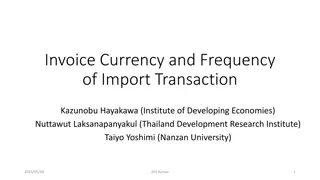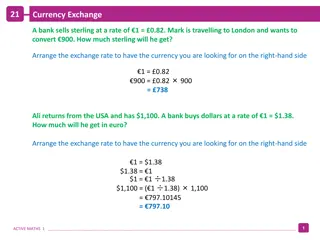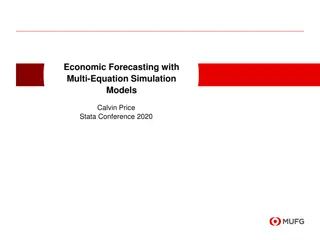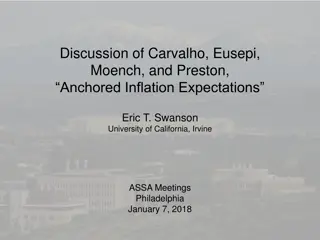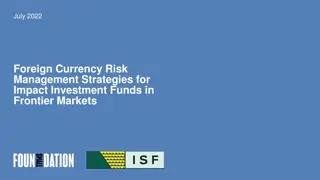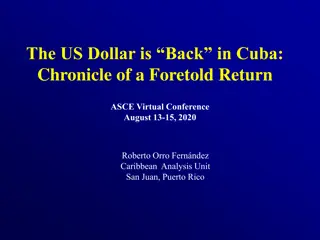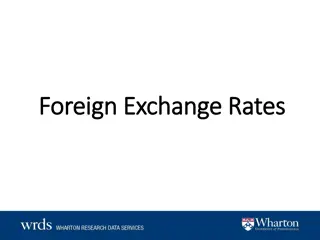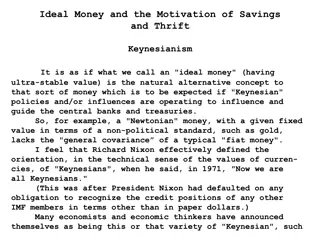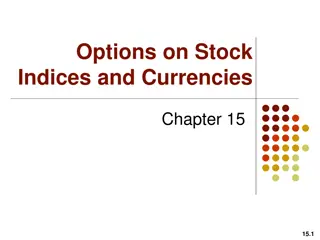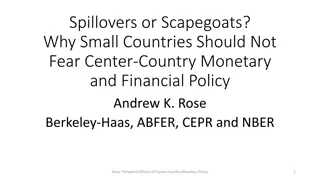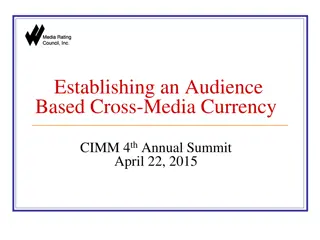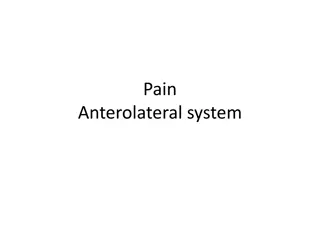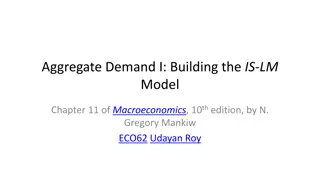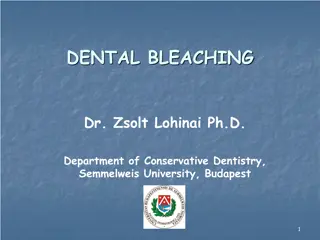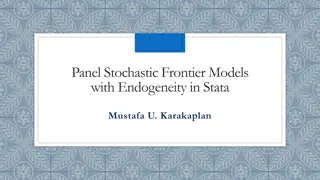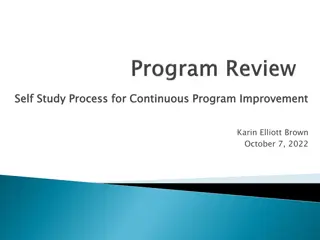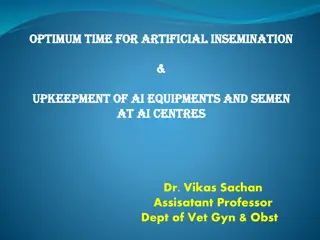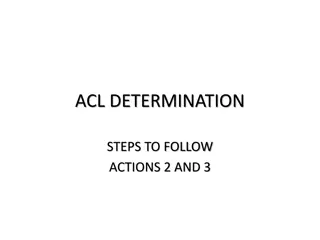Understanding Endogenous Optimum Currency Areas
Mundell's Optimum Currency Area Criteria and the concept of setting the endogeneity stage are discussed in relation to business cycles and trade integration. Approaches to empirically test business cycle synchronization and the theoretical ambiguity with empirical clarity are examined in the context of common monetary policies and currency areas.
Download Presentation

Please find below an Image/Link to download the presentation.
The content on the website is provided AS IS for your information and personal use only. It may not be sold, licensed, or shared on other websites without obtaining consent from the author. Download presentation by click this link. If you encounter any issues during the download, it is possible that the publisher has removed the file from their server.
E N D
Presentation Transcript
Endogenous Optimum Currency Areas: Where Do We Stand? Andrew K. Rose Berkeley-Haas ABFER, CEPR and NBER Rose: PEIF April 2017 1
Disclaimer Rose: PEIF April 2017 2
Mundells Optimum Currency Area Criteria Consider two economies with sticky prices and business cycles Q: When should these economies share a common money? A: When two criteria satisfied: Criterion 1: Large benefits from one instead of two currencies (large trade) AND Criterion 2: Low opportunity cost of relinquishing monetary sovereignty Criterion 2 likely to be satisfied when: Business cycles are synchronized (common monetary policy appropriate), or Labor markets sufficiently flexible, or Risk-sharing sufficiently high (e.g., cross-area fiscal redistribution system) Rose: PEIF April 2017 3
Setting the Endogeneity Stage (Frankel-Rose) Consider two economies with business cycles For some reason, a trade barrier falls Makes Criterion 1 more likely to be satisfied (trade rises ... how much?) Usually policy-driven, such as trade/non-trade/monetary barriers Q: Are the business cycles of the two economies likely to become more or less synchronized (Criterion 2 less/more likely)? Less if countries specialize more because of deeper trade integration(inter- industry trade), and sector-specific shocks are important More with fewer idiosyncratic shocks (e.g., from national monetary policies), because common (rather than sector-specific) shocks grow, or because intra- industry trade dominates inter-industry trade (little specialization) Rose: PEIF April 2017 4
How to Tackle the Issue Empirically? Two-step common procedure to test direction of effect empirically: 1. Create measure of Business Cycle Synchronization (BCS) a. Detrend output/unemployment for area i to create business cycle deviation b. Repeat for area j c. Create measure of coherence between business cycles for i and j (BCS) 2. Link BCS to integration between i and j Usually regress BCS on bilateral trade between i and j, appropriately normalized Rose: PEIF April 2017 5
Theoretical Ambiguity, Empirical Clarity In practice, Frankel-Rose found strong empirical results Positive: more trade leads to more synchronized business cycles IV results often larger than OLS Robust: many authors, especially Baxter and Kouparitsas But exceptions exist (more below) Also issues of size of effect Kose-Yi puzzle more below Rose: PEIF April 2017 6
Quick Notes Trade only one possible measure of integration Many barriers to integration exist Decline possible because of policy or technology Financial integration easy to measure, likely important, big recent changes Fits well into OCA framework (risk-sharing can be private) Labor market integration of special political interest recently Why only link trade/financial integration to BCS? Are other OCA criteria endogenous? Labor markets? Price rigidities? Insurance mechanisms? Rose: PEIF April 2017 7
Cautionary Note 1 Potential feedback from BCS to trade implies simultaneity problem Plausible because monetary regimes (fixed exchange rates/CU ) can easily affect both trade and BCS directly, often by design So instrumental variables seem generally appropriate Rose: PEIF April 2017 8
Cautionary Note 2 Many steps involved in empirical procedure Some examples 1. Which raw series to consider for business cycles? (GDP? Unemployment?) 2. How to convert raw series to business cycles? (BK/CF/HP-detrending/growth rates?) 3. How to cohere business cycles across countries? (Correlation coefficient?) 4. Measure integration through outputs (e.g., trade/asset flows) or inputs (barriers)? 5. Which measure of integration/trade to link to BCS? (Bilateral trade? Normalization?) 6. Which instrumental variables? 7. What tradeoff in time/space data span? (Large cross-section or time-series?) Affords researchers considerable discretion/measurement error A general cause for concern Rose: PEIF April 2017 9
Cautionary Note 3 Follow-up to point 7 above: Some BCS-Trade Linkages associated with change in structure of economy Specialization/Movement of resources across sectoral boundaries But Not All Switch from idiosyncratic national monetary shocks to common international monetary shocks Hence unclear what is appropriate frequency for empirics In practice need to examine changes over time of BCS across countries I.e., time-series changes of cross-sectional phenomena An unusual, unfamiliar space Rose: PEIF April 2017 10
Tangent: A Unified Framework Imbs (RES 2004) provides a unifying statistical framework BCS driven by: a) trade integration; b) specialization; c) financial integration But also: Specialization driven by a) trade integration; b) financial integration Trade integration driven by specialization Financial integration ... ? Estimates simultaneous system via 3SLS But means researcher must take views on many structures Considerable data/estimation requirements 3SLS means mistakes anywhere spill over Hence satisfying to purists, but unpopular Rose: PEIF April 2017 11
Quantifying the Trade BCS Effect Empirically In 2008, I conducted a meta-analysis of 20 studies linking trade to BCS Estimates of from standard estimating equation: BCSijt = + *ln(tradeijt) + controls + ijt Rose: PEIF April 2017 12
Literature (as of 2008) Beta SE Beta SE Baxter and Kouparitsas Bower and Guillenmineau Gruben, Koo and Mills 2005 0.13 0.03 2002 0.06 0.02 2006 0.02 0.01 Imbs 2003 0.03 0.02 Calder Calderon, Chong and Stein 2007 0.01 0.00 Imbs Inklaar, Jong-a- Pin and de Haan 2004 0.07 0.02 2007 0.02 0.00 2005 0.12 0.04 Choe Clark and van Wincoop 2001 0.03 0.01 Kose and Yi Kose, Prasad and Terrones 2005 0.09 0.02 2001 0.09 0.03 2003 0.01 0.00 Crosby 2003 0.05 0.06 Kumakura 2006 0.06 0.04 Fidrmuc 2004 0.02 0.04 Kumakura Otto, Voss and Willard 2007 0.06 0.01 Fiess Frankel and Rose 2007 0.12 0.06 2001 0.05 0.09 1998 0.09 0.02 Shin and Wang 2004 0.08 0.08 Rose: PEIF April 2017 13
Meta-Analysis of Trade Impact on BCS Pooled Estimate of .020 Estimation Technique Fixed Lower Bound of 95% .016 Upper Bound of 95% .023 Random .043 .031 .054 Rose: PEIF April 2017 14
Finding 1 Increased trade seems to increase business cycle synchronization Not a universal consensus, but pretty strong If anything, the size of the linkage may be too large Rose: PEIF April 2017 15
Effect Size: the Trade-Comovement Puzzle Kose-Yi (AER 2001, JIE 2006) the positive effect of trade on BCS is too large to be consistent with standard international RBC model (first developed by Backus, Kehoe and Kydland) Theoretical exercises with calibration, productivity shocks 2- and 3-country versions Consider different levels of: a) financial integration; b) transport costs Findings: Too little trade in theory (compared to data) Too little responsiveness of BCS to trade in theory (again, compared to data) Rose: PEIF April 2017 16
Kose-Yi has Spawned Literature to Consider Potential Resolutions Puzzle lends itself to further research Explanations include Production fragmentation , trade in intermediate inputs (Ng, JIE 2010, Di Giovanni and Levchenko AEJM 2010, Johnson 2013) Firm behavior (foreign affiliates, multinationals, Burstein, Kurz and Tesar JME 2008, Kleinert et al AEJM 2015) Fluctuations in extensive margin of trade (Liao and Santacreu JIE 2015) My view: many possibilities, little consensus as yet Unclear if this matters for OCA endogeneity Unusual: challenge to EOCA result is size but not sign Rose: PEIF April 2017 17
Finding 2 Little strong evidence of any other strong linkages to BCS Baxter-Kouparitsas (2005) did Leamer-style EBA analysis: findings are negative, in the sense that we found many variables not to be robust. Specifically, total trade measures are fragile, as are the measures of the similarity of total and bilateral trade. Factor endowment variables, including measures of education, capital, and arable land, were all found to be fragile. All gravity variables except for distance were found to be fragile. Ditto De Haan, Inklaar and Jong-A-Pin (2008) Rose: PEIF April 2017 18
Possible Exception: Financial Integration and BCS Considerable analysis Likely motivation: of rising capital mobility Policy-induced or mostly technological? Or ease of measurement? Economically important Private risk-sharing a substitute for public (fiscal) risk-sharing Rose: PEIF April 2017 19
Risk-sharing should enhance production specialization, lower BCS Financial integration plausibly leads to lower BCS Empirically valid: Kalemli-Ozcan, Sorensen, Yosha (JIE 2001) Kalemli-Ozcan, Sorensen and Yosha (AER 2003) True within regions of US, Japan, UK, Canada Less specialization across countries than regions because risk-sharing is (much) larger within countries than between countries Clever, compelling comparison of international and intranational phenomena Kalemli-Ozcan, Papaioannou and Peydro (JF 2013) Strong negative effect of banking integration on BCS Rose: PEIF April 2017 20
But ... No Consensus Exists Imbs (RES 2004) Question marks because imperfect information/herding/contagion: more financial integration could raise BCS (financial crises often regional) In practice, most specialization not a result of country endowments, or integration (real or financial) Rather, stage of development (GDP p/c) drives specialization Also: Dees and Zorell (2011) No effect of financial linkages on BCS Rose: PEIF April 2017 21
Who Wins the Horse-Race? Integration often deepening in both real/trade and financial markets Literature creates two presumptions: More financial integration probably implies decline in BCS Empirically uncertain More real integration implies rise in BCS Strong empirically On net? Relatively little work directly comparing size of effects ECB study (Dees and Zorell 2012): real effects tend to dominate Ripe for further study Rose: PEIF April 2017 22
Tangential Wistful Note High expectations for enhanced private risk-sharing early in EMU Ex: abstract of Kalemli-Ozcan, Sorensen and Yosha (2004): We find that risk sharing in the European Union (EU) has been increasing over the past decade due to increased cross-ownership of assets across countries. Industrial specialization has also been increasing over the last decade, and we conjecture that risk sharing plays an important causal effect by allowing countries to specialize without being subject to higher income risk even though the variability of output may increase. We further find that the asymmetry of GDP fluctuations in the EU has declined steeply over the last two decades. This may be due to economic policies becoming more similar as countries were adjusting fiscal policy in order to meet the Maastricht criteria We expect to see a further rise in risk sharing between EU countries, accompanied by more specialization. The resulting increase in GDP asymmetry should be minor, however, and will have small welfare costs, because increased risk sharing should lower income (GNP) asymmetry. Rose: PEIF April 2017 23
Which Leads to the Key Case: EMU Has OCA endogeneity changed BCS inside EMU? Special focus should be on core/periphery divergence Has BCS endogeneity had same (lack of) effect everywhere? Given our current knowledge, requires two possible steps: 1. Effects of EMU on integration (real/financial/labor ) 2. Effects of integration on BCS Rose: PEIF April 2017 24
EMU: Considerable Confusion De Haan, Inklaar and Jong-A-Pin (JES 2008) survey concluded: We conclude that business cycles in the euro area have gone through periods of both convergence and divergence Higher trade intensity is found to lead to more synchronization, but the point estimates vary widely. The evidence for other factors affecting business cycle synchronization is very mixed. Considerable work post-dating de Haan et al confirms mixed EMU picture BCS rising/high: Aguiar-Conraria and Soares (2011); Artis and Zhang (2008); Gachter and Ridel (2014); Goncalves, Rodrigues and Soares (2009) BCS falling/low: Caporale, De Santis and Girardi (2015); Christodoulopoulou (2014) Unclear: Crespo-Cuaresma and Fernandez-Amador (2013); Lehwald (2012) Literature cries out for EMU-focused meta-analysis/synthesis! Methodology for meta-analysis has improved considerably in last decade Rose: PEIF April 2017 25
Outside EMU Little work on determinants of BCS/OCA endogeneity But many (multilateral) currency unions exist: Eastern Caribbean Central Africa Western Africa Southern Africa And many more proposed (rarely seriously) Rose: PEIF April 2017 26
Bilateral Currency Unions/Dollarization Almost no work at all Ex: Bulgaria vs Romania Ex: Ecuador vs Peru Mechanisms should be similar, perhaps cleaner Unanswered Question: How do bilateral currency unions (between large/small) differ from multilateral currency unions? Few serious multilateral CUs until EMU EMU too recent to study ... until recently ... Rose: PEIF April 2017 27
Related Literature: Statistical Characterization of Business Cycle Movements Tends to be high-tech, low-ec Focus is on characterizing business cycles Tends to ignore determinants of BCS Ignore international linkages (focus on global/multilateral influences like oil prices, terms of trade, ) Kose, Otrok and Whiteman (JIE 2008) Crucini, Kose, and Otrok (RED 2011) Kose, Otrok and Prasad (IER 2012) Global/regional/country-specific variation Different periods of time Different aggregates (output, consumption, ) Rose: PEIF April 2017 28
The Litany: Complaints on the Endogenous Optimum Currency Area Literature Where do we stand? Rose: PEIF April 2017 29
Criticism 1 The literature is now boring Lends itself to derivative empirics New data (more countries! Years! Measures of financial integration!) New techniques (wavelets, spectral coherence, ) So a citation-generator But little in the way of novel data collection Unlike much empirical work in economics Rose: PEIF April 2017 30
Criticism 2 (Literature not boring enough) Does the BCS endogeneity literature care about endogeneity? In our original EJ paper, Frankel and I found that IV doubled the magnitude of the effect of trade on BCS Used gravity IVs: (log) distance, adjacency, common language Ironically, this point has been forgotten BCS seems clearly endogenous with respect to trade, but trade itself might be endogenous in the relevant sense More plausibly, both trade and BCS might be driven by other forces Accordingly, most estimates were IV until around 2005 Yet most of recent literature ignores potential feedback If intra-national and international data give same results, this may not be important (Imbs) but many authors find opposite Rose: PEIF April 2017 31
Criticism 3 The literature is narrow Other OCA criteria not really addressed Difficulty with quantifying labor-mobility? Price-stickiness? Or reforms? Some work (e.g., Bongardt and Torres 2016; Dyson 2000; Hancke and Rhodes 2016), but without rigorous theory or empirics Promising early start by Duval and Elmeskov (2006), but little follow-up Finding: use OECD data on labor/product market policies through 2003, find that high unemployment, crises, healthy budgets and small country size spur reform Hints that EMU slows reform, but based on little data How long does it take interest groups to emerge in this context? More generally, quantifying endogenous policy response to monetary union seems worthwhile little evidence, but also little work Rose: PEIF April 2017 32
Criticism 4 Too much focus on EMU without any consensus/encompassing framework emerging Little work on currency unions outside EMU Alesina and Barro s work an important but dated exception, dealing with possible OCAs Rose: PEIF April 2017 33
Criticism 5 (Scylla and Charybdis) Everyone agrees: trade-BCS is inappropriately sized Too Large in Theory Kose-Yi critique and many follow-ups Too Small in Practice Meta-studies: point estimates of trade-BCS effect .02; EMU-trade effect .1 So increase in correlation coefficient is (.02*10) = .20 Economically big (BCS sample average is .22) change, but still leaves BCS low Rose: PEIF April 2017 34
Criticism 6 A literature of great academic interest EMU the obvious test case Lurking in the Background: Currency unions in theory and practice OCA criteria: well-established, well understood in theory Somewhat quantified empirically But demanding (if mis-applied) five convergence criteria necessary for EMU entry remain orthogonal to OCA criteria! Rose: PEIF April 2017 35


